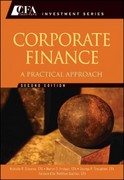A switch from straight-line to accelerated depreciation would: A. increase the NPV and decrease the first year
Question:
A switch from straight-line to accelerated depreciation would:
A. increase the NPV and decrease the first year operating income after taxes.
B. increase the first year operating income after taxes and decrease the NPV.
C. increase both the NPV and first year operating income after taxes.
Barbara Simpson is a sell-side analyst with Smith Riccardi Securities. Simpson covers the pharmaceutical industry. One of the companies she follows, Bayonne Pharma, is evaluating a regional distribution center. The financial predictions for the project are as follows:
• Fixed capital outlay is €1.50 billion.
• Investment in net working capital is h0.40 billion.
• Straight-line depreciation is over a six-year period with zero salvage value.
• Project life is 12 years.
• Additional annual revenues are €0.10 billion.
• Annual cash operating expenses are reduced by €0.25 billion.
• The capital equipment is sold for €0.50 billion in 12 years.
• Tax rate is 40 percent.
• Required rate of return is 12 percent.
Simpson is evaluating this investment to see whether it has the potential to affect Bayonne Pharma’s stock price. Simpson estimates the NPV of the project to be €0.41 billion, which should increase the value of the company.
Simpson is evaluating the effects of other changes to her capital budgeting assumptions.
She wants to know the effect of a switch from straight-line to accelerated depreciation on the company’s operating income and the project’s NPV. She also believes that the initial outlay might be much smaller than initially assumed. Specifically, she thinks the outlay for fixed capital might be €0.24 billion lower, with no change in salvage value.
When reviewing her work, Simpson’s supervisor provides the following comments: “I note that you are relying heavily on the NPV approach to valuing the investment decision. I don’t think you should use an IRR because of the multiple IRR problem that is likely to arise with the Bayonne Pharma project.However, the equivalent annual annuity would be a more appropriate measure to use for the project than the NPV. I suggest that you compute an EAA.”
Step by Step Answer:

Corporate Finance A Practical Approach
ISBN: 9781118217290
2nd Edition
Authors: Michelle R Clayman, Martin S Fridson, George H Troughton, Matthew Scanlan





